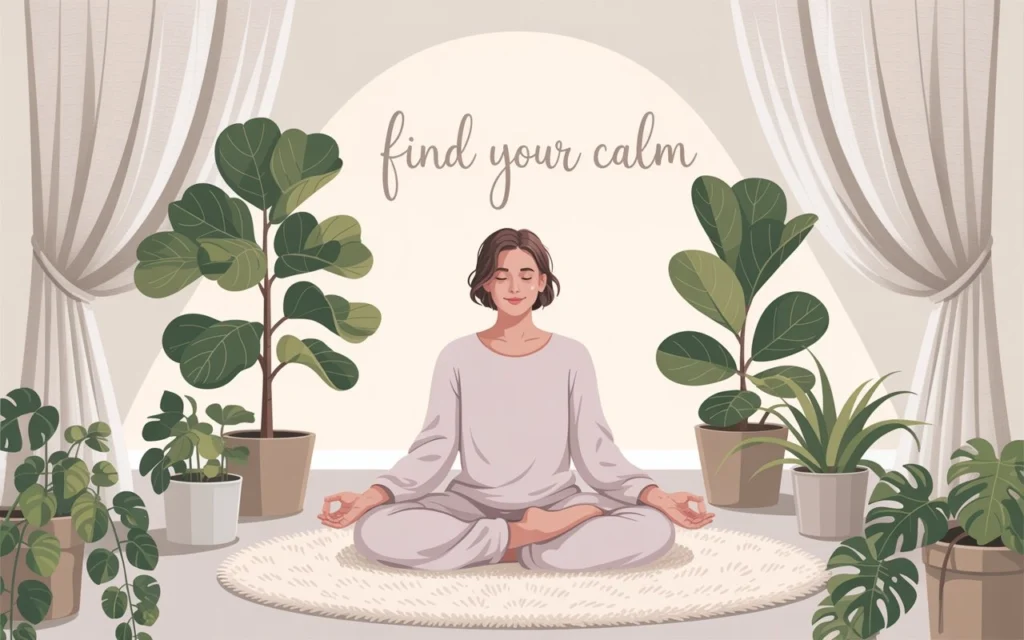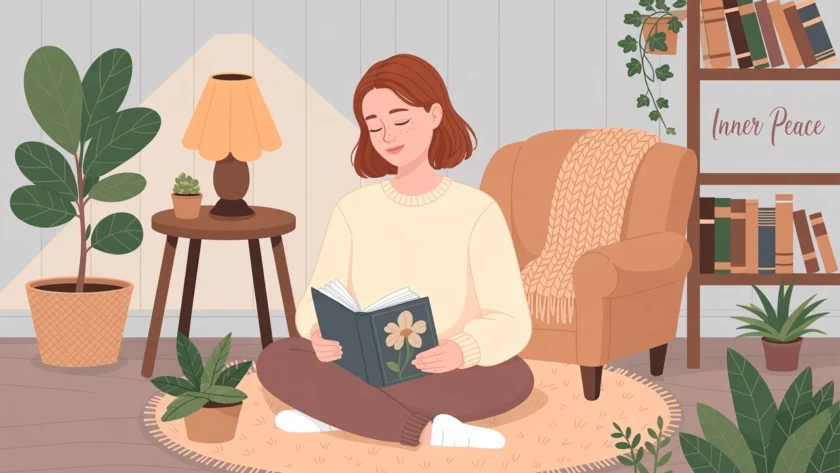Your home should be your sanctuary, not another source of stress. Here’s how to transform your living space into a haven of peace that supports your journey through anxiety.
The front door clicks shut behind you after another overwhelming day, and instead of feeling relief, your shoulders tense even more. The pile of mail on the counter catches your eye, the dishes in the sink seem to multiply, and suddenly your own home feels like just another place where anxiety can take hold. Sound familiar?
After years of battling generalized anxiety disorder myself, and now helping others through their own journeys, there’s one truth that keeps surfacing: our environment profoundly impacts our emotional well-being. When we’re dealing with anxiety, our homes can either become refuges of peace or unwitting contributors to our stress.
The beautiful thing about creating a calm home environment is that it doesn’t require a complete overhaul or unlimited budget. Sometimes the smallest changes—a cleared surface here, softer lighting there—can shift the entire energy of a space. More importantly, when we intentionally design our homes with anxiety in mind, we’re taking an active role in our healing journey, and that empowerment itself becomes therapeutic.
Let me share what has worked for countless individuals dealing with generalized anxiety disorder, including practical steps you can start implementing today to transform your home into the peaceful sanctuary you deserve.
Understanding How Environment Affects Anxiety
Before diving into specific strategies, it helps to understand why our surroundings matter so much when we’re dealing with anxiety. Our brains are constantly scanning for threats—it’s how we’re wired for survival. When we have generalized anxiety disorder, this scanning system becomes hyperactive, picking up on subtle environmental cues that might escape others’ notice.
Clutter signals chaos to an anxious brain. Harsh lighting can trigger stress responses. Even colors can influence our nervous system, either promoting calm or heightening alertness. The good news? Once we understand these connections, we gain power to work with our brain’s natural responses instead of against them.
During my own most challenging seasons with anxiety, certain rooms in my house became places where panic attacks seemed more likely to occur. Looking back, these spaces shared common characteristics: poor lighting, accumulated clutter, and a general sense of disorder that mirrored my internal state. When we began making intentional changes to these environments, the shift was remarkable—not miraculous, but genuinely helpful.
Scripture reminds us that “God is not a God of disorder but of peace” (1 Corinthians 14:33). While this verse addresses church gatherings, the principle applies beautifully to our personal spaces. Creating order and peace in our homes reflects God’s character and supports the peace He desires for our hearts.

Decluttering: The Foundation of Calm
Let’s start with the most impactful change you can make: reducing clutter. This doesn’t mean your home needs to look like a magazine spread, but rather that every item should have a purpose and a place. Clutter creates visual noise that keeps our minds busy processing unnecessary information, which is exhausting for anyone but especially challenging for those with generalized anxiety disorder.
Begin with one small area—perhaps your bedside table or the kitchen counter where mail accumulates. Set a timer for fifteen minutes and focus solely on that space. Ask yourself three questions about each item: Do I use this regularly? Does it serve a specific purpose? Does seeing it bring me peace or stress?
The fifteen-minute rule prevents the decluttering process from becoming overwhelming, which often happens when we try to tackle entire rooms at once. Remember, we’re not aiming for perfection; we’re creating breathing room for both our physical space and our minds.
Consider implementing the “one in, one out” principle moving forward. When something new enters your home, something else finds a new home elsewhere. This simple practice prevents clutter from rebuilding while making you more intentional about what you bring into your sanctuary.
Storage solutions don’t need to be expensive. Repurpose boxes, use baskets you already own, or designate specific drawers for categories of items. The key is consistency—when everything has a designated place, maintaining order becomes a simple habit rather than an overwhelming task.
Lighting: Setting the Mood for Peace
Lighting might seem like a small detail, but it plays a massive role in how we feel within our spaces. Harsh overhead fluorescent lights can trigger stress responses, while soft, warm lighting promotes relaxation and calm. When dealing with anxiety, we want to minimize anything that puts our nervous system on high alert.
Natural light should be your first priority. Open curtains and blinds during the day to let in as much sunlight as possible. Natural light helps regulate our circadian rhythms, which directly impacts sleep quality—and good sleep is crucial for managing anxiety. Position yourself near windows when possible for reading, working, or relaxing.
For evening hours, consider replacing bright overhead lights with table lamps, floor lamps, or string lights that cast a gentler glow. Dimmer switches are wonderful investments that allow you to adjust lighting based on your needs and the time of day. The goal is creating what lighting designers call “layered lighting”—multiple soft sources rather than one harsh overhead fixture.
Candles can be particularly soothing, with the added benefit of engaging multiple senses through gentle scent and the mesmerizing quality of flickering flames. If open flames make you nervous (anxiety often comes with heightened safety concerns), battery-operated candles provide similar visual benefits without worry.
Salt lamps have gained popularity for good reason—they emit a warm, amber glow that many find calming. While scientific evidence for their health claims remains limited, the soft light they provide certainly contributes to a peaceful atmosphere.
Color Psychology for Anxiety Relief
Colors influence our emotions more than we often realize. When designing a home environment that supports anxiety management, understanding basic color psychology helps guide decisions about paint, bedding, artwork, and accessories.
Cool colors like soft blues, gentle greens, and muted lavenders tend to have calming effects on the nervous system. These colors are reminiscent of nature—sky, water, and plants—which our brains associate with safety and tranquility. This doesn’t mean your entire home needs to be painted in these hues, but incorporating them strategically can support feelings of peace.
Warm, muted colors can also promote comfort when used thoughtfully. Soft beiges, warm grays, and gentle creams create cozy, nurturing environments. However, avoid overly bold or bright colors in spaces where you seek rest and relaxation, as these can be overstimulating for anxious minds.
Consider the psychology of your bedroom colors especially carefully, since quality sleep is fundamental to anxiety management. Cooler tones generally promote better sleep, while warmer colors might be more appropriate for social spaces where you want to feel energized and connected.
Remember that you don’t need to repaint entire rooms to incorporate calming colors. Throw pillows, blankets, artwork, and plants can introduce soothing hues without major expense or commitment.
Creating Designated Calm Spaces
Every person dealing with anxiety benefits from having specific areas in their home designated for relaxation and peace. This might be a corner of your bedroom with a comfortable chair and good reading light, a section of your living room with soft cushions, or even a small area on your porch or patio.
The key is intentionality. This space should be reserved for activities that promote calm—prayer, meditation, reading, journaling, or simply quiet reflection. When we consistently use a space for peaceful activities, our brains begin to associate that area with relaxation, making it easier to shift into a calm state when we’re there.
Your calm space doesn’t need to be large or expensive to create. A simple meditation cushion on the floor, a comfortable throw blanket, and perhaps a small table for your Bible, journal, or a cup of tea can transform any corner into a retreat space.
Consider what sensory elements might enhance your calm space. A small essential oil diffuser, a soft blanket with pleasing texture, or artwork that brings you peace can all contribute to the atmosphere. The goal is engaging your senses in ways that signal safety and calm to your nervous system.
Some people find it helpful to establish small rituals around using their calm space—perhaps lighting a candle, saying a brief prayer, or taking three deep breaths before settling in. These rituals help create a transition from the busyness of daily life to a more peaceful state of mind.
Managing Sound and Creating Quiet
Noise pollution in our homes often goes unnoticed until we specifically tune in to it. The constant hum of appliances, traffic sounds from outside, or even the ticking of clocks can contribute to underlying stress for those with heightened anxiety sensitivity.
Start by identifying the sounds in your environment. Spend a few minutes in each room simply listening. What do you hear? Some sounds might be necessary but could be minimized—perhaps by placing rubber mats under appliances or oiling squeaky hinges. Others might be eliminated entirely.
Consider introducing pleasant sounds that can mask less desirable noise. A small tabletop fountain provides the soothing sound of flowing water. Wind chimes on a porch or patio create gentle, natural music. Some find white noise machines helpful for sleep, while others prefer the sound of a fan or even a playlist of nature sounds.
Plants serve double duty in creating calm environments—they improve air quality and add natural beauty while also absorbing some sound. Larger plants with broad leaves are particularly effective for this purpose.
If your home is located in a noisy area, explore soundproofing options that fit your budget. Heavy curtains, rugs, and wall hangings all help absorb sound. Even rearranging furniture to create more barriers between living spaces and noise sources can make a meaningful difference.
Remember that silence itself is healing. Creating pockets of quiet in your day—perhaps early morning coffee without radio or television, or an evening ritual of reading without background noise—gives your nervous system regular opportunities to reset.
Incorporating Nature and Living Elements
Bringing elements of nature indoors has profound benefits for anxiety management. Our brains are wired to find natural environments restorative, and even small touches of nature in our homes can activate these same calming responses.
Houseplants are one of the most effective ways to bring nature indoors. They improve air quality, add life and color to spaces, and provide the satisfaction of nurturing something living. If you’re worried about keeping plants alive, start with hardy varieties like pothos, snake plants, or rubber trees that thrive with minimal care.
Natural materials in furniture and decor—wood, stone, woven fibers—add warmth and texture that synthetic materials often lack. A wooden cutting board displayed on a counter, stone coasters on a coffee table, or a woven basket for storage all contribute to a more natural, grounding atmosphere.
Fresh flowers, when budget allows, bring both natural beauty and pleasant fragrance to spaces. Even a single stem in a simple vase can transform the feeling of a room. If fresh flowers aren’t practical, high-quality artificial flowers have become remarkably realistic and can provide similar visual benefits.
Consider creating a small indoor herb garden on a windowsill. Herbs like lavender, rosemary, and mint provide pleasant scents while offering the therapeutic activity of tending to growing things. Plus, you’ll have fresh herbs available for cooking and tea-making.
Natural light, as mentioned earlier, is crucial. If your home lacks adequate natural light, consider full-spectrum light bulbs that mimic sunlight, especially during darker winter months when seasonal effects can compound anxiety symptoms.
Technology Boundaries for Home Peace
While technology serves many beneficial purposes, it can also contribute to anxiety when not managed intentionally. Creating boundaries around technology use in your home helps protect your mental space and promotes genuine rest.
Consider establishing tech-free zones in your home—perhaps the bedroom or dining room table. These spaces become reserved for human connection, rest, and nourishment without the distraction and stimulation that screens provide.
If you use your phone as an alarm clock, consider investing in a simple alarm clock instead, allowing you to charge your phone outside the bedroom. This reduces the temptation to scroll through news or social media first thing in the morning or last thing at night, both times when we’re particularly vulnerable to anxiety-provoking content.
Create designated times for checking emails, social media, and news rather than having constant access throughout your day. Many people find it helpful to avoid news and social media for the first hour after waking and the last hour before bed, protecting these crucial transition times.
Consider which notifications you actually need to receive immediately versus those that can wait until you choose to check your devices. Most notifications can be turned off without any real consequence to your life, but with significant benefit to your peace of mind.
If you work from home, creating clear boundaries between work and personal space becomes even more crucial. This might mean closing a laptop and putting it away at the end of the workday, or physically turning a desk to face away from the living area when work hours are complete.
Practical Implementation: Starting Small
Creating a calm home environment might feel overwhelming when viewed as a whole project, but remember that small, consistent changes accumulate into significant improvements over time. The key is starting where you are with what you have.
Choose one room to focus on first—ideally the space where you spend the most time or where you most need to feel calm. This might be your bedroom if sleep is a struggle, your living room if that’s where you relax in the evenings, or your kitchen if mealtime anxiety is an issue.
Set aside just fifteen minutes each day for home environment improvements. This might be decluttering one drawer, rearranging furniture to improve flow, adding a plant to a windowsill, or simply cleaning and organizing one small area. Consistency matters more than intensity—fifteen minutes daily will create more lasting change than occasional weekend marathons that lead to burnout.
Make a simple list of changes you’d like to implement, but avoid turning it into an overwhelming to-do list. Instead, think of it as a menu of options you can choose from based on your energy level and available time on any given day.
Remember that progress isn’t always linear. Some days, simply maintaining the peaceful spaces you’ve already created is accomplishment enough. On difficult anxiety days, your calm environment will support you; on better days, you can continue making improvements.
The Spiritual Dimension of Sacred Space
As people of faith, we understand that our homes can become more than just comfortable living spaces—they can become places where we encounter God’s peace in tangible ways. The process of creating calm environments becomes itself a spiritual practice, an act of stewarding the gifts God has given us.
Consider incorporating elements of your faith journey into your home environment in ways that bring peace rather than obligation. This might be a small cross on the wall, a basket of devotional books within easy reach, or simply a comfortable chair positioned where morning light streams in—perfect for quiet time with God.
Prayer can become part of your home-creating process. Ask God to bless the spaces where you live and to help them become places of peace for everyone who enters. Scripture tells us that “the peace of God, which transcends all understanding, will guard your hearts and your minds in Christ Jesus” (Philippians 4:7). Our homes can become physical reminders of this spiritual reality.
Many find it meaningful to dedicate specific spaces in their homes to prayer and reflection. This doesn’t require a separate room—a corner with a comfortable chair, good lighting, and perhaps a small table for your Bible and prayer journal can become a sacred space within your daily environment.
Remember that hospitality is also part of our calling as followers of Christ. A calm, welcoming home becomes a gift not only to ourselves but to others who need rest and peace. When we create environments that soothe anxiety, we’re often creating spaces where others feel welcomed and cared for as well.
Moving Forward with Hope and Intention
Creating a home environment that supports anxiety management is both an art and a journey. There’s no single formula that works for everyone, and your needs may change with seasons of life. The key is maintaining intentionality about how your environment affects your well-being and making adjustments accordingly.
Remember that perfection isn’t the goal—peace is. Your home doesn’t need to look like a designer magazine to be a source of comfort and calm. Some of the most peaceful homes are those that clearly reflect the personalities and lives of the people who inhabit them, complete with the beautiful imperfections that make them real.
Start with one small change today. Clear one surface, adjust one light, move one piece of furniture, or add one element of nature to your space. Notice how that change affects how you feel in that space. Let success build on success, and be patient with yourself when energy is low or anxiety is high.
Your home can become a powerful ally in your journey toward greater peace and emotional well-being. By creating an environment that supports calm, you’re taking an active role in caring for yourself—and that itself is a form of hope made visible.
Trust that small changes compound over time, that God meets us in the practical details of daily life, and that the peace you’re cultivating in your physical environment can become a reflection of the deeper peace He offers your heart.
Take that first small step today. Your future self—and your anxious moments—will thank you for the gift of a truly peaceful home.Retry




